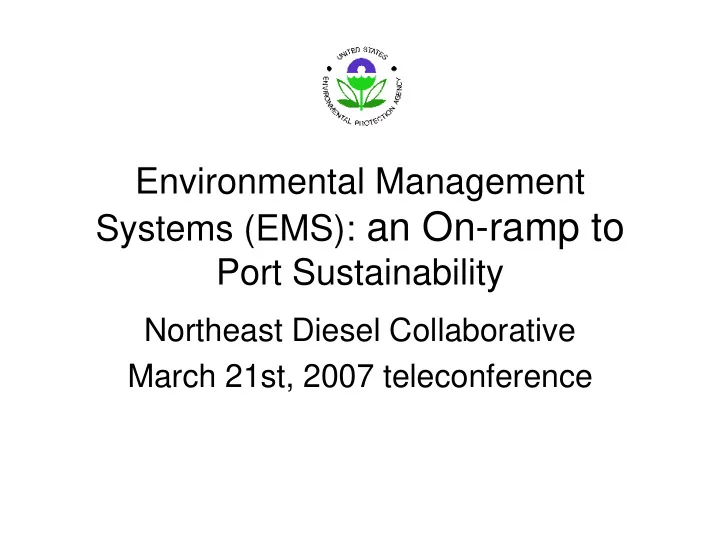

Environmental Management Systems (EMS): an On-ramp to Port Sustainability Northeast Diesel Collaborative March 21st, 2007 teleconference
Purpose of Presentation • Present and discuss why EMSs make sense for ports. – What do ‘sustainability’ and ‘environmental stewardship’ mean? – What are Environmental Management Systems (EMSs) & how are they helping ports address air quality & become sustainable? – What are some progressive green practices? – Why is it important to engage stakeholders, including local communities?
What does sustainability mean? • “The ability to meet today’s global economic, environmental and social needs without compromising the opportunity for future generations to meet theirs.” - Brundtland Commission, 1987 • 3 Ps - Profit/Prosperity, Planet, People • 3 Es – Economy, Environment, Social Equity
Sustainability and Ports • A sustainable port community is economically viable, environmentally and socially responsible, safe and secure . - Working definition of Kathleen Bailey, EPA Port Sector Liaison • The American Association of Port Authorities (AAPA) has recently formed a Sustainability Task Force.
Environmental stewardship is critical for sustainability. • EPA’s vision for Environmental Stewardship – “ where all parts of society actively take responsibility to improve environmental quality and achieve sustainable results .” – A value – a core value & a way to create business value – A behavior – doing more than reg. compliance
What are progressive ports doing to become better environmental stewards? • Developing environmental management systems (EMSs) for existing and new facilities, e.g Ports EMS Assistance Project. • Measuring and reporting on continuous improvement in environmental performance, via the EMS. • Paying more attention to community concerns.
Overview of Environmental Management Systems (EMS) • What is an EMS? • Why create an EMS? • Basic EMS Elements • Port Benefits from EMS
What is an EMS? • An EMS is a formal system for managing the environmental footprint of a Port. – Incorporates environmental considerations into day-to-day operations and strategic planning. – Provides a structured framework designed to achieve continual environmental improvement.
EMS Plan-Do-Check-Act Continual Improvement Management Environmental Review Policy Planning Checking & Corrective Action Implementation & Control
Addressing Air Quality via an EMS • Planning: Look at all the environmental aspects , i.e elements of facility activities, products or services, that have the environmental impact of degrading air quality. Air emissions from tug boat is and example of an env. aspect. – Doing an emissions inventory will help determine env. aspects. – Then select significant aspects and develop a Strategy/Action Plan with objectives and targets for reducing emissions in daily operations (and in future expansion). • Implementing: Implement the Strategy/Action Plan. • Checking and corrective action: Measure and report progress; Reassess & refine strategy/plan over time. • Management Review: Provides support and allocation of resources.
Why create an EMS? • Key drivers as identified by 9 ports in the 1 st Ports EMS Assistance Project: • Improve environmental awareness. • Improve organizational efficiency & effectiveness. • Improve environmental performance. • Improve public awareness and confidence.
Ports’ Benefits from EMS • Virginia – Cargo handling equipment purchasing program reduced air emissions by 30% over 3 yr; rec’d AAPA award • Portland – Reduced idling by 79%; 5% marine electric power from windmills. • Corpus Christi – saved $27K, reduced 134K lbs of waste; rec’d local conservation award. • NY/NJ – conserved 134 million gal. of potable water in ’05 by fixing leaks, & saved $655,000
Organizational Evolution
Progressive Green Practices - Examples of what some ports are doing • Linking operational efficiency and environmental protection, e.g. gate systems, chassis pools • Air Toxics: Inventorying current and projected emissions; Creating and implementing reduction strategies, e.g. off peak truck trips; creating regional performance measures. • Pro-active integration of land use & transportation plng. • Applying the EMS “systems approach” to security (Houston, Long Beach, Corpus Christi, NY/NJ, Portland) • Green procurement practices; LEED building standards • Water: Installing permeable asphalt where appropriate • Renewable Energy: Wind and Solar power; Hybrid engines; Energy Star computers
Why is it important to engage stakeholders, including local communities. • LICENSE TO OPERATE & GROW.
What communities sometimes fear or don’t like about ports • Air and water pollution, and potential health effects • Road congestion • Destruction of wetlands, habitat • Noise during construction and operation • Night lighting and glare • Dust • Visual impacts, e.g. ‘ugly’ cranes • Competition with recreational uses of water/land • Disturbance of cultural resources
What communities want from ports, besides jobs and goods: • A say in decisions that affect their lives. Public Involvement Spectrum: Inform, Consult, Engage, Collaborate, Empower • A transparent decision-making process, especially for new projects. • Monitoring and reporting on environmental issues., e.g. ambient air and water quality monitoring, and (EMS) objectives/targets for continuous improvement in environmental performance.
EPA document under development on EMS and the pursuit of port sustainability • Port Authority Reviewers wanted for this 25 page document in early April. • If you are interested in being a reviewer, please contact me: Kathleen Bailey, Port Sector Liaison, EPA Office of Policy, Economics and Innovation, Sector Strategies Program, 202/566-2953, bailey.kathleen@epa.gov
Other Resources • http://www.epa.gov/sectors/ports • http://www.epa.gov/ems • http://www.peercenter.net/ewebeditp ro/items/073F8587.pdf
Recommend
More recommend